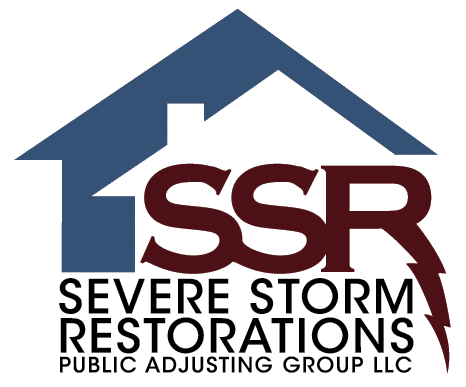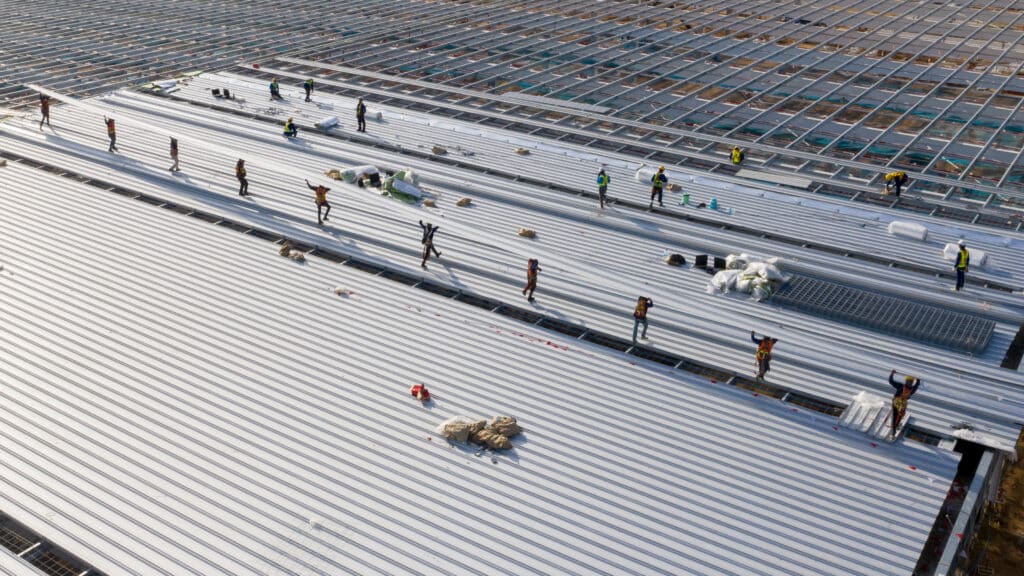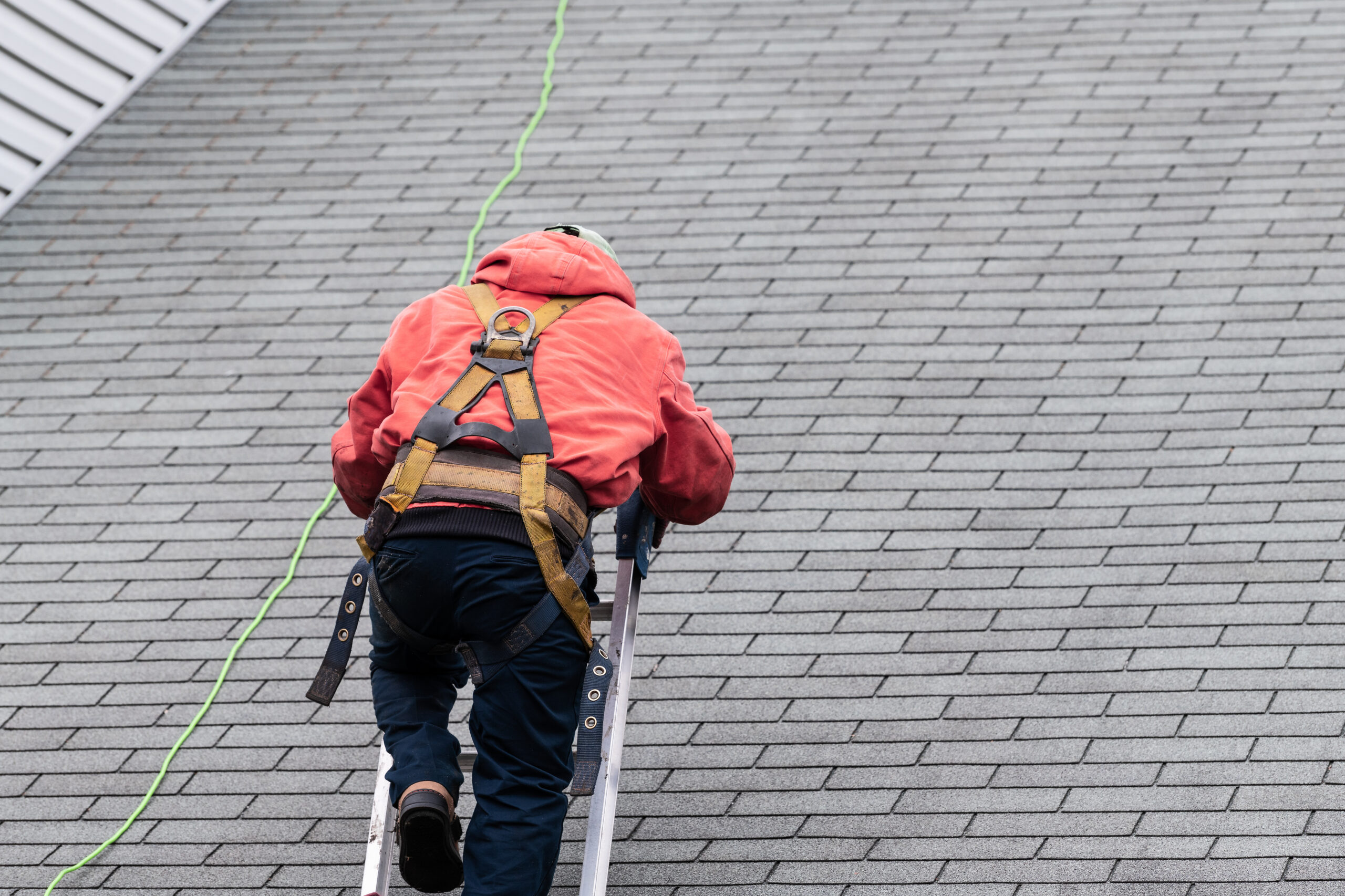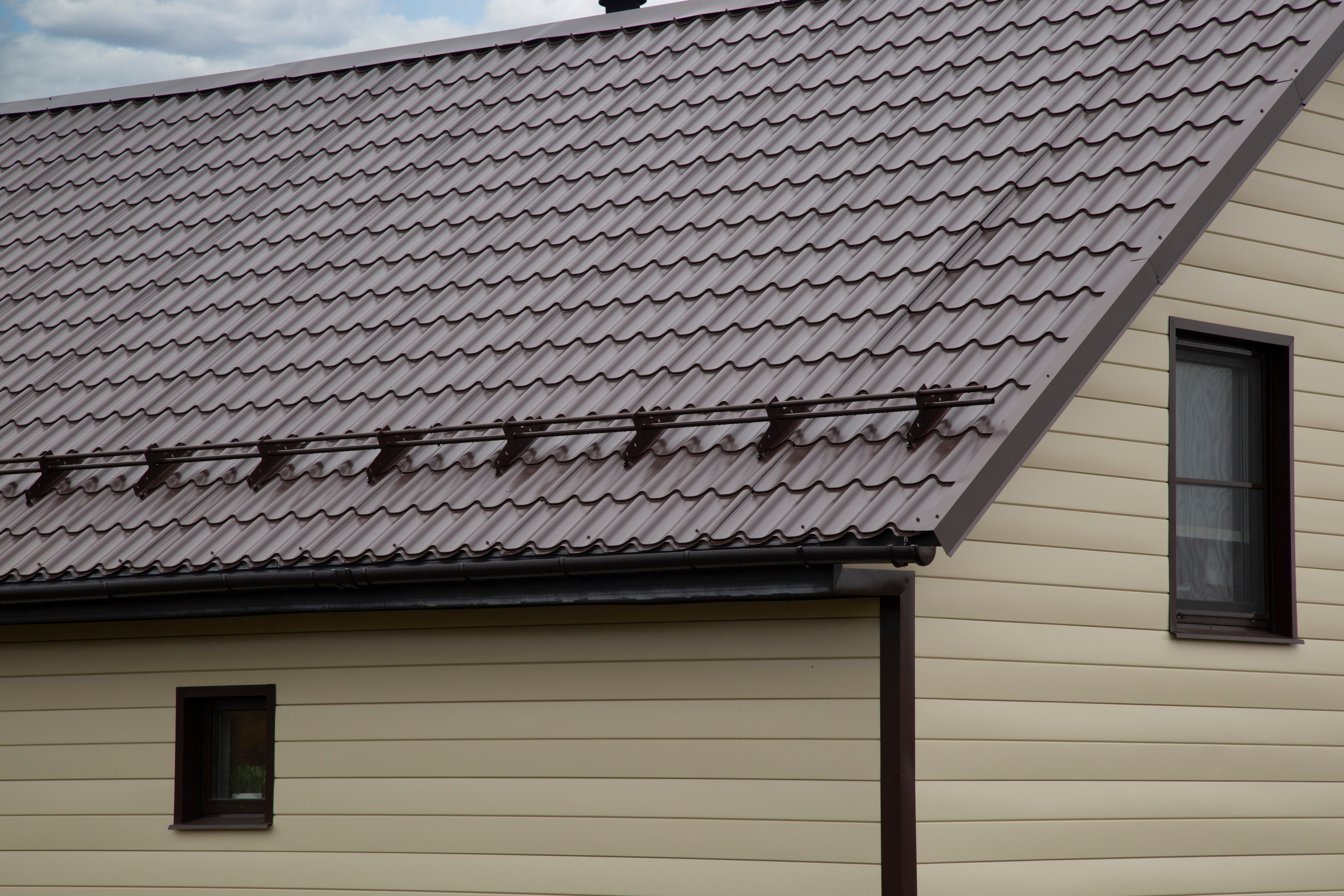In today’s environmentally-conscious business landscape, sustainability has evolved from being a trend to an integral part of how companies operate, especially when it comes to construction and building maintenance. For commercial buildings, where large roofing systems cover expansive areas, sustainable practices have a significant impact. The roof of a building plays a critical role in regulating temperature, managing energy consumption, and protecting the structure from environmental factors such as sun, rain, and wind. By embracing sustainable roofing solutions, commercial properties can make a substantial contribution to environmental conservation.
Sustainable roofing solutions offer businesses the opportunity to lower their environmental impact while also delivering practical benefits such as improved energy efficiency, reduced operational costs, and increased roof longevity. In the long run, investing in eco-friendly roofing systems translates into financial savings, fewer maintenance requirements, and a positive brand image associated with green initiatives. Sustainability in roofing also aligns with broader environmental regulations and goals, making it a sound business choice that supports both financial and ecological health.
The demand for sustainable roofing is growing due to the emphasis on reducing carbon footprints and conserving natural resources. Commercial buildings with sustainable roofing systems experience lower energy consumption as these roofs are designed to reduce heat absorption and improve insulation. Whether it’s through the use of reflective roofing materials, green roofs, or integrating renewable energy sources like solar panels, sustainable roofing solutions provide businesses with numerous advantages.
Furthermore, sustainable roofing helps address challenges such as stormwater management, urban heat island effects, and air quality issues, making it an essential component of urban development. For businesses that prioritize corporate social responsibility, sustainable roofing offers a way to actively contribute to environmental preservation while reaping tangible operational benefits. With these considerations in mind, the importance of sustainable roofing cannot be overstated.
In the following sections, we will delve into specific sustainable roofing options for commercial buildings, examining the benefits and considerations of each, so you can make an informed decision that aligns with your business’s sustainability goals.
What Is Sustainable Roofing?
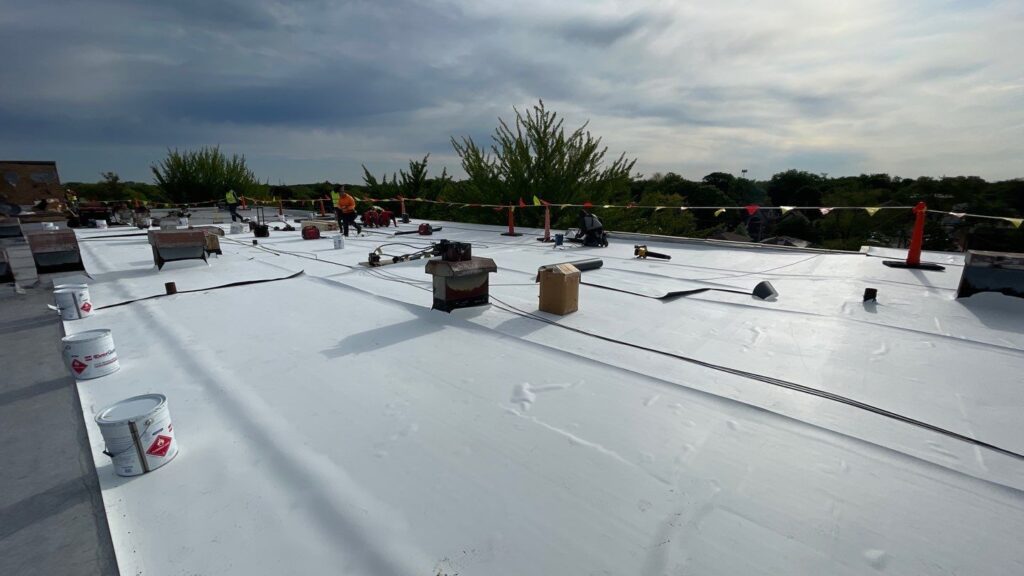
Sustainable roofing is more than just a trend; it represents a forward-thinking approach to roofing that prioritizes environmental responsibility, energy savings, and long-term durability. By utilizing materials and techniques that are kinder to the environment, sustainable roofing solutions aim to minimize the carbon footprint of buildings while providing the highest level of protection and energy efficiency. These systems incorporate features such as recycled materials, reflective surfaces, and even vegetation, all of which contribute to reducing the overall environmental impact of a building.
One of the key elements of sustainable roofing is the use of eco-friendly materials. This can include roofing made from recycled products, such as rubber, metal, or plastic, which help reduce the waste that would otherwise end up in landfills. Additionally, natural materials like clay, slate, or wood are often used, as they are biodegradable and sustainable when sourced responsibly. These materials are durable and can withstand harsh weather conditions, offering long-term protection with minimal environmental impact.
Energy efficiency is another crucial aspect of sustainable roofing. Roofs that reflect sunlight, known as cool roofs, help reduce heat absorption, thereby lowering the need for air conditioning in the building. This not only cuts down on energy consumption but also reduces utility costs, making it a financially sound investment for businesses. Furthermore, the integration of renewable energy sources, such as solar panels, into the roofing system allows buildings to generate clean energy, further enhancing their sustainability.
Durability and longevity are significant benefits of sustainable roofing systems. Many of these eco-friendly roofs are designed to last longer than traditional materials, reducing the need for frequent replacements and repairs. This not only saves money in the long term but also reduces the amount of waste generated by roofing projects. Sustainable roofs are built to endure extreme weather conditions, resist damage, and provide effective insulation, ensuring that they offer a reliable solution for years to come.
Ultimately, sustainable roofing contributes to a healthier environment by reducing waste, conserving energy, and minimizing the overall ecological footprint of commercial and residential buildings. By adopting these systems, property owners can make a positive impact on the planet while also benefiting from cost savings, improved building performance, and enhanced durability.
Why Sustainability Matters for Commercial Buildings
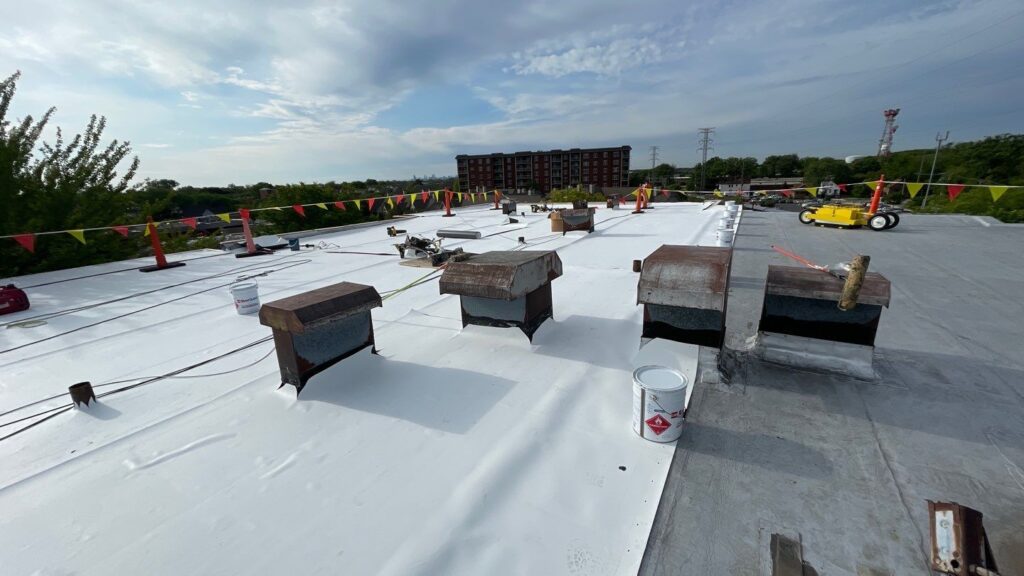
The environmental impact of commercial buildings is substantial, with roofing systems playing a crucial role in both resource consumption and energy usage. Large commercial roofs cover vast surface areas and, when not designed with sustainability in mind, can contribute to excessive energy waste, pollution, and the depletion of natural resources. Fortunately, sustainable roofing solutions offer an effective way to mitigate these negative impacts while delivering tangible benefits to property owners.
One of the most significant advantages of sustainable roofing is its ability to reduce energy consumption. Traditional roofs absorb heat from the sun, causing indoor temperatures to rise and increasing the reliance on air conditioning systems. In contrast, sustainable roofs, such as cool roofs or those made with reflective materials, are designed to reflect sunlight and prevent excessive heat buildup. This reduces the need for air conditioning, leading to lower energy consumption and decreased utility bills, especially in hot climates.
In addition to energy efficiency, sustainable roofing also plays a pivotal role in managing stormwater runoff. Green roofs, which are covered with vegetation, help absorb rainwater and reduce the strain on drainage systems during heavy storms. This not only helps prevent flooding but also reduces the risk of water damage to the building’s structure. Cool roofs, with their reflective surfaces, help combat the urban heat island effect, where urban areas experience higher temperatures due to the concentration of buildings and pavement. By minimizing heat buildup, these roofing systems contribute to a cooler, more sustainable urban environment.
Lowering the carbon footprint is another critical aspect of sustainable roofing. Many sustainable roofing materials are made from recycled or renewable resources, reducing the environmental impact associated with the manufacturing and transportation of new materials. By using recycled products or materials like metal, rubber, or sustainable wood, commercial buildings can significantly reduce the amount of waste sent to landfills and cut down on the emissions generated during production.
Cost savings are an additional benefit that comes with investing in sustainable roofing solutions. While the initial cost of installing a sustainable roof may be higher than traditional roofing, the long-term savings can be substantial. Sustainable roofs are designed for durability and longevity, meaning they require fewer repairs and replacements over their lifetime. This reduces maintenance costs and prevents the need for frequent, costly roof replacements. As a result, business owners can save money in the long run while also contributing to environmental sustainability.
In conclusion, sustainable roofing is a win-win solution for both the environment and commercial building owners. By reducing energy consumption, improving water management, lowering the carbon footprint, and offering long-term cost savings, sustainable roofs provide a practical and environmentally responsible approach to roofing that benefits both businesses and the planet.
Types of Sustainable Roofing Solutions
Here are some of the most popular sustainable roofing solutions for commercial buildings:
3.1. Green Roofs (Living Roofs)
Overview: Green roofs, also known as living roofs, are one of the most eco-friendly roofing solutions available. These roofs are covered with plants and vegetation, providing numerous environmental and energy-saving benefits.
Benefits:
- Energy Efficiency: Green roofs offer excellent insulation, keeping buildings cooler in the summer and warmer in the winter.
- Stormwater Management: The vegetation absorbs rainwater, reducing stormwater runoff and minimizing the risk of flooding in urban areas.
- Air Quality: Green roofs filter pollutants from the air, improving overall air quality.
- Biodiversity: Green roofs can provide habitats for birds, insects, and other wildlife in urban environments.
- Aesthetic Appeal: Living roofs offer an attractive, natural appearance that enhances the visual appeal of commercial buildings.
Considerations:
- Green roofs are heavier than traditional roofs and may require additional structural support.
- They require regular maintenance to ensure plant health and roof integrity.
3.2. Cool Roofs
Overview: Cool roofs are designed to reflect more sunlight and absorb less heat compared to standard roofing materials. This type of roof is typically made from reflective materials such as white coatings, light-colored membranes, or metal roofing.
Benefits:
- Energy Savings: By reflecting sunlight, cool roofs reduce the need for air conditioning, leading to significant energy savings, especially in hot climates.
- Extended Roof Life: Cool roofs experience less heat stress, which can prolong the roof’s life and reduce the need for repairs.
- Reduced Urban Heat Island Effect: Cool roofs help mitigate the urban heat island effect, where cities become significantly warmer than surrounding areas due to heat-absorbing materials like asphalt and concrete.
Considerations:
- Cool roofs are most effective in sunny, hot climates and may not offer as much benefit in colder regions.
3.3. Solar Roofs
Overview: Solar roofing systems integrate solar panels directly into the roofing material, allowing commercial buildings to generate their own electricity from renewable sources.
Benefits:
- Energy Independence: Solar roofs enable businesses to generate their own electricity, reducing reliance on the grid and lowering energy bills.
- Environmental Impact: By harnessing solar energy, businesses can reduce their carbon footprint and support renewable energy efforts.
- Tax Incentives: Many regions offer tax incentives, rebates, or credits for installing solar roofing systems, making them a financially attractive option.
Considerations:
- Solar panels require an upfront investment and should be installed by professionals to ensure proper functionality.
- Solar panels are most effective in areas with high sun exposure.
3.4. Recycled Roofing Materials
Overview: Many sustainable roofing options now use recycled materials such as rubber, plastic, and metal. These materials are repurposed from post-consumer waste and offer an eco-friendly alternative to traditional roofing.
Benefits:
- Environmental Impact: Using recycled materials reduces the need for raw materials, lowering the environmental impact of manufacturing.
- Durability: Recycled roofing materials are often as durable as their non-recycled counterparts, providing long-lasting protection.
- Cost-Effective: Recycled roofing materials can be more affordable than traditional materials due to reduced production costs.
Considerations:
- Recycled roofing materials may vary in quality, so it’s essential to choose high-grade options from reputable manufacturers.
3.5. Metal Roofing
Overview: Metal roofing is one of the most durable and sustainable roofing materials available for commercial buildings. Metal roofs can last up to 50 years or more, and they are often made from recycled materials.
Benefits:
- Longevity: Metal roofs have a longer lifespan than most traditional roofing materials, reducing the need for replacements.
- Energy Efficiency: Metal roofs can be coated with reflective finishes to reduce heat absorption, making them more energy-efficient.
- Recyclability: At the end of their life, metal roofs can be fully recycled, reducing waste.
Considerations:
- Metal roofs can be noisy during rain or hailstorms, although insulation can mitigate this issue.
- They require professional installation to ensure proper sealing and longevity.
Key Benefits of Sustainable Roofing Solutions
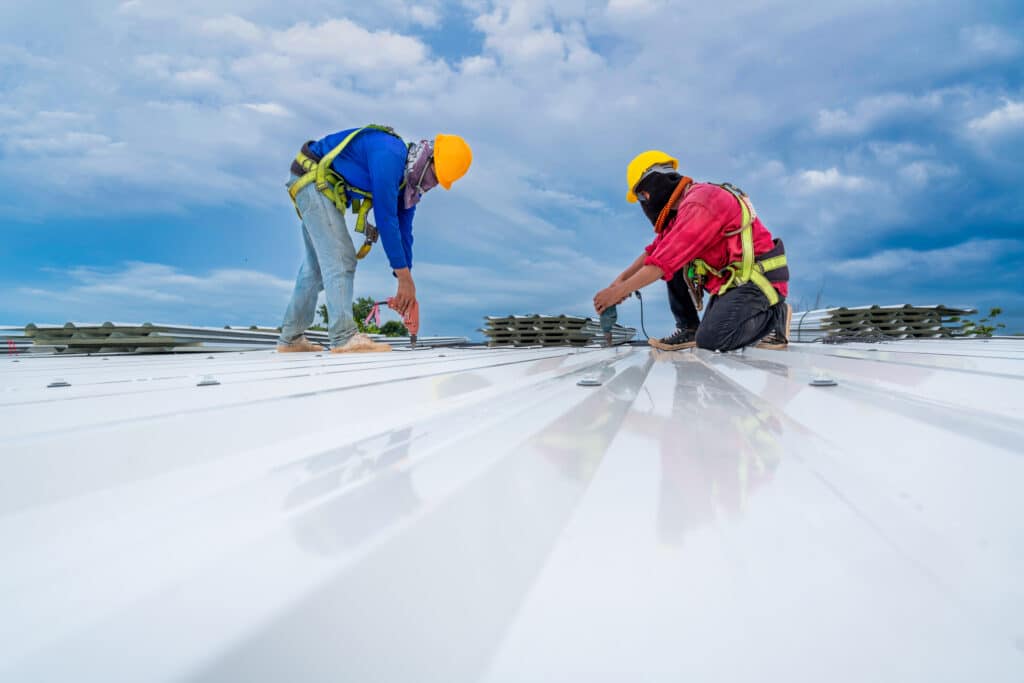
Adopting sustainable roofing solutions for your commercial building comes with a wide range of benefits that go beyond just being environmentally conscious. By choosing these roofing systems, you’re making a smart business decision that impacts energy efficiency, durability, aesthetics, and even air quality. Let’s take a closer look at the key reasons why sustainable roofing is an excellent choice for commercial buildings.
4.1. Energy Efficiency and Cost Savings
One of the most compelling reasons to adopt sustainable roofing is its energy-saving potential. Cool roofs, which are designed to reflect sunlight, and green roofs, which provide natural insulation, can drastically reduce the amount of heat that enters or escapes your building. This results in a significant decrease in the need for artificial heating and cooling, which translates directly into lower energy bills. While the initial cost of installing these energy-efficient roofing systems might be higher than traditional options, the long-term savings from reduced energy consumption often offset these upfront expenses. Over time, you’ll notice that your building operates more efficiently, saving you money while reducing your carbon footprint.
4.2. Increased Roof Longevity
Sustainable roofing systems are often built with durability in mind. Materials like metal, recycled rubber, and natural slate can withstand severe weather conditions far better than traditional asphalt shingles. Green roofs, with their layers of vegetation, provide natural protection from the elements and help regulate temperature changes that would otherwise degrade a roof. These eco-friendly roofing materials and systems tend to last much longer than conventional roofs, often with a lifespan extending several decades. This added longevity reduces the frequency of repairs or replacements, further lowering long-term costs and providing a strong return on your investment.
4.3. Improved Air Quality and Stormwater Management
In urban environments, sustainable roofs, particularly green roofs, can play a crucial role in improving air quality. Green roofs act as natural filters, absorbing carbon dioxide and other pollutants, helping to purify the air around your building. This is especially valuable in cities with high pollution levels, where improving air quality can positively impact the health of employees and the surrounding community. Additionally, green roofs offer excellent stormwater management benefits. By absorbing rainwater, they reduce the amount of runoff that can overwhelm urban drainage systems and contribute to flooding. This feature not only protects your building from water damage but also helps manage stormwater in a way that’s beneficial to the local ecosystem.
4.4. Enhanced Building Value and Aesthetic Appeal
A sustainable roof does more than just improve functionality—it can also enhance the visual appeal of your building. Green roofs, solar panel-integrated roofs, and sleek, reflective cool roofs give your commercial property a modern and environmentally-conscious aesthetic. This can significantly boost curb appeal, which is attractive to tenants and potential buyers who prioritize sustainability. Additionally, buildings with sustainable features often have higher property values, as they are seen as forward-thinking investments that will save future owners money on energy costs and maintenance. Having a green or energy-efficient roof can differentiate your property in a competitive real estate market, making it a more attractive option for environmentally-conscious businesses and buyers.
In conclusion, adopting sustainable roofing solutions offers commercial building owners a wide range of benefits. From energy efficiency and cost savings to improved air quality, stormwater management, and aesthetic appeal, these roofing systems are a smart choice for anyone looking to make a long-term investment in their property. By choosing sustainable roofing, you’re not only reducing your environmental impact but also enhancing the overall value, durability, and functionality of your building.
How to Choose the Right Sustainable Roofing Solution
Selecting the right sustainable roofing solution for your commercial building depends on several factors, including your budget, location, and specific building needs. Here are a few tips to guide your decision-making process:
- Consider Your Climate: The climate of your location plays a significant role in determining which roofing solution is best. For example, cool roofs and green roofs are ideal for hot, sunny climates, while metal and solar roofs are versatile options for various weather conditions.
- Evaluate Roof Durability: If your building is in an area prone to extreme weather, such as hurricanes or hail, consider roofing materials that offer superior durability, such as metal or polyurethane coatings.
- Analyze Long-Term Costs: While sustainable roofing solutions may have a higher upfront cost, they often result in lower maintenance and energy costs over time. Calculate the potential savings on energy bills and reduced repairs to determine which option offers the best return on investment.
- Consult with a Professional: Speak with a professional roofing contractor who specializes in sustainable roofing solutions. They can provide expert guidance on which materials and systems will work best for your commercial building.
Conclusion
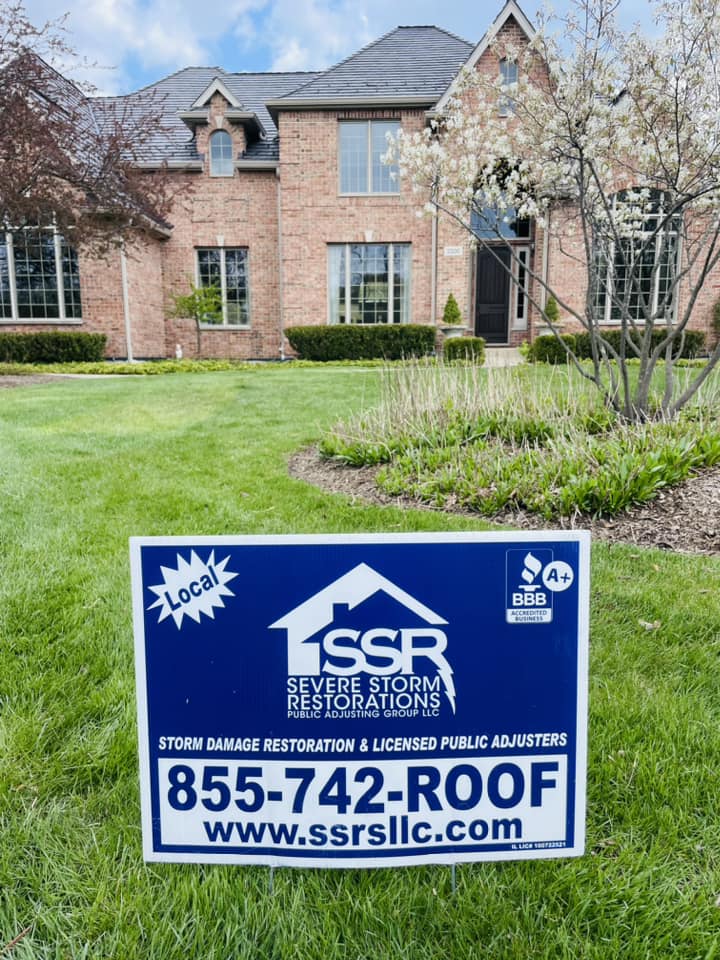
Investing in sustainable roofing solutions for commercial buildings is an environmentally responsible and economically beneficial choice. From cool roofs and green roofs to solar panels and recycled materials, these roofing options offer significant advantages in terms of energy efficiency, durability, and cost savings. By adopting eco-friendly roofing practices, you not only reduce your carbon footprint but also enhance the longevity and value of your property.
If you’re considering sustainable roofing solutions for your commercial building, consult with a professional roofing contractor to explore the best options for your specific needs. Contact Severe Storm Restorations LLC today at (855) 742-7663 or visit severestormrestorations.com to learn more about how we can help implement sustainable roofing solutions that benefit both your business and the environment.
